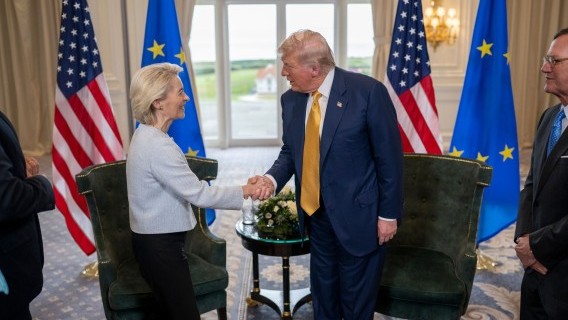Resume af teksten:
EU og USA har frigivet en “Framework Agreement” for at præcisere den aftale, der blev lavet for fire uger siden i Skotland mellem Donald Trump og Ursula von der Leyen. Denne aftale er ikke juridisk bindende, men beskriver bl.a. en 15% amerikansk told på de fleste europæiske varer og EU’s hensigt om at reducere visse tariffer på amerikanske varer. Aftalen medfører øget europæisk køb af amerikansk energi og investeringer i USA. Sektorer som lægemidler og halvledere er omfattet af 15% tolden, mens bilindustrien står overfor betinget toldnedsættelse. De europæiske hensigtserklæringer savner bindekraft, og aftalen tillader fortolkning, som kan føre til eskalation. Europa forpligter sig til at købe mere amerikansk militærhardware. Aftalen medfører også justeringer af flere EU-politikker for at imødekomme USAs interesser. Dokumentet antyder Europas afhængighed af USA og kan ses som skadebegrænsning snarere end en sejr for Europa.
Fra ING:
The EU and the US have just released the so-called ‘Framework Agreement’, offering more binding details on the arrangement reached four weeks ago in Scotland

President Donald Trump with EC President Ursula von der Leyen in Scotland late last month
This framework agreement on “Reciprocal, Fair, and Balanced Trade” is not a legally enforceable treaty but rather a clarification of the handshake deal between US President Donald Trump and European Commission President Ursula von der Leyen. It confirms key elements:
A 15% US tariff on most European goods
European intentions to reduce or eliminate certain tariffs on US goods
Increased European purchases of US energy
Greater investment in the US
You can read the full statement here
The agreement outlines which sectors will be subject to the 15% tariff. For Europe, it’s a relief that pharmaceuticals and semiconductors are included in this group, sparing them from even higher tariffs. The situation with cars is more complex: they will only be moved into the 15% category (down from the current 27.5%) once Europe fulfils its commitment to lower tariffs on US goods. This conditionality is just one example of the agreement’s ambiguity, which leaves room for both interpretation and potential escalation.
Other elements, such as Europe’s “intentions” (not commitments) to reduce tariffs, purchase more US energy, and invest more in the US, also lack binding force. Here’s a notable one: The EU… “ plans to substantially increase procurement of military and defence equipment from the United States, with the support and facilitation of the US government.”
Europe even hands in some of its pet projects
Beyond tariffs, the agreement includes provisions that target former EU flagship policies. These include flexibility for US companies under the Carbon Border Adjustment Mechanism, the Corporate Sustainability Due Diligence Directive (CSDDD), and the Corporate Sustainability Reporting Directive (CSRD). The European Commission has even handed in some of its pet projects in order to satisfy the US side of the negotiations.
In summary, the framework agreement reinforces the impression formed after the Scotland deal: the only real upside for Europe is that the outcome could have been worse, and that there is now some clarity. However, this clarity remains fragile and could quickly dissolve. The agreement contains numerous elements that could spark future tensions and escalation. Implementation, monitoring and enforcement of many of the intentions is not always clear.
On a more sobering note, the framework agreement serves as a painful reminder of Europe’s current dependency on the US – more so than vice versa. It’s difficult to call this a “deal” when it reads more like a document of damage control for Europe.
Hurtige nyheder er stadig i beta-fasen, og fejl kan derfor forekomme.
